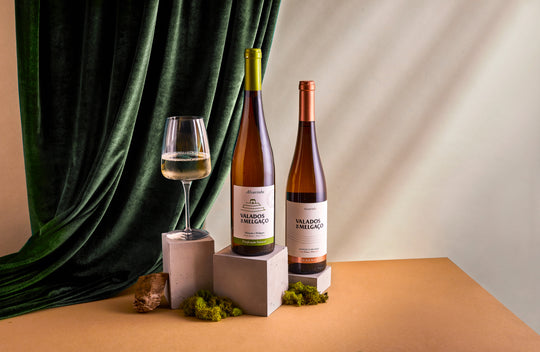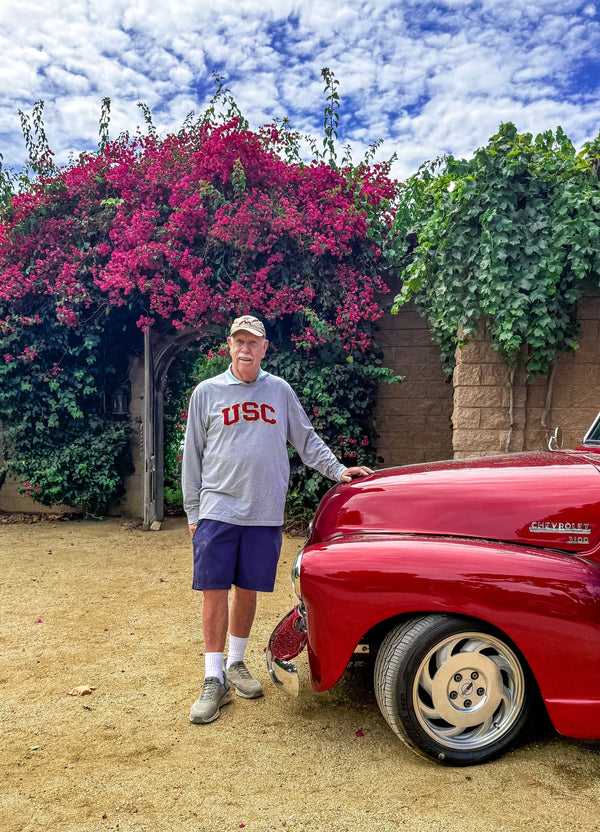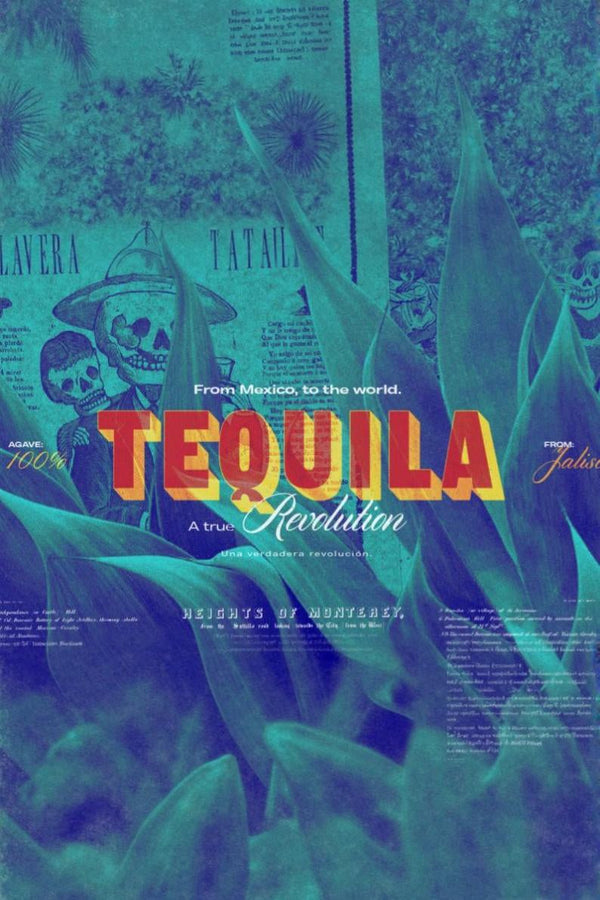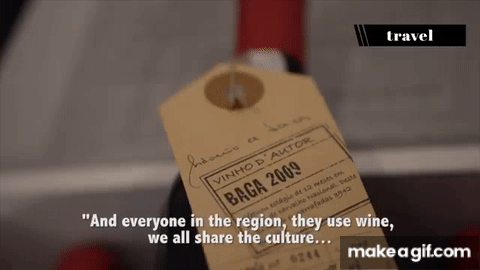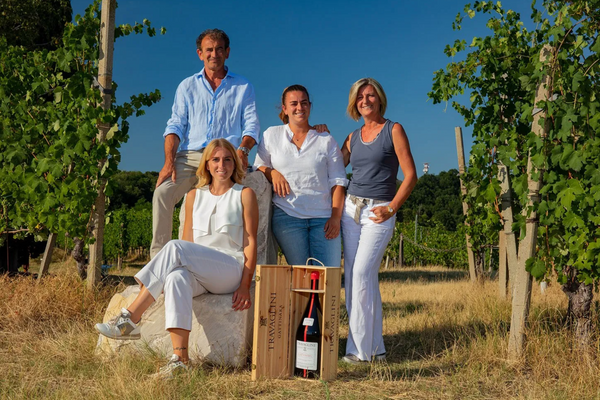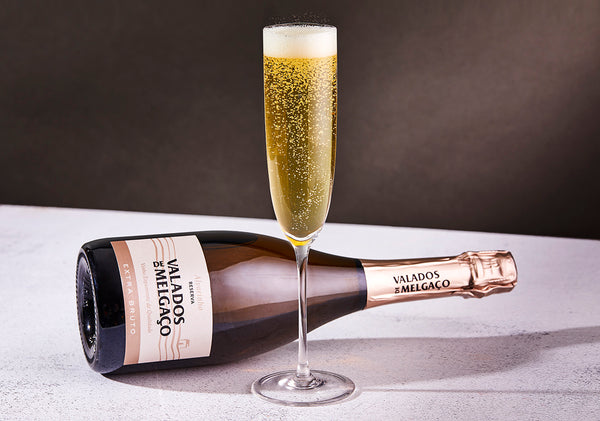António Maçanita, Making Wine the Way we Think is Right

I met António Maçanita on ‘holy ground,’ literally. He was finishing construction for his new winery in Alentejo, at a rebuilt monastery called Herdade da Oliveira in Evora, Portugal. António is known to be one of the leading winemakers in Portugal, but there’s a lot more to him than just great craftsmanship. As founder and owner of Fita Preta, António is also a consultant winemaker for over 13 other wineries in Portugal through his consultancy company Wine ID.
To me, his philosophy around the world of wine, people, and nature as a whole is simply remarkable.
HIS EARLY YEARS
Born in Lisbon, António’s father is a chemistry teacher from the Azores island, while his mother is from Alentejo.
In his early life, António’s knew plenty of structure and discipline. He was a successful Olympic gymnast who competed with the national team. At 16 he switched his focus to rugby, again playing for the national team.
In his free time, António loved surfing and spear fishing. His love for the water had him seeking out marine biology after high school. But a teacher inspired him to get into agro industries. This was a happy accident, as his real intent was to get into agronomy. We can thank the stars that brought him to us!
The program featured an interesting education about ways of living that had long been taken for granted, such as the careful, patient process of turning milk into cheese or grapes into wine. António felt he could generate true value in the world by reviving these ancient ways.
His first vineyard at the age of 20 was in the Azores archipelago in 2000, breaking ground in San Miguel Island. It was located in a very remote and windy part of the island, and if there was a prize for extreme wine growing, he definitely would have won it. As a nature lover in its most raw form, even António described the ordeal as crazy. His vineyard was soon hit by a dry storm. As the ocean pounded away on the coastal rocks, it threw atomized salt onto his land, burning a chunk of the vineyard. It was a lesson best learned early on.
But his passion for the Azores would not leave him. He returned again to the islands later in his career, running a trial with a forgotten varietal called Terrantez do Pico (2010). António recalled his love for the land, saying “I wanted to do something with Azores.”
There were only 89 Terrantez do Pico plants in various Azorean vineyards. He worked closely with the local government to protect the plants throughout the process. Together they did a massive cloning program in order to grow this vine. “I would vinify it and the result is a fantastic wine unlike any other. High in acidity, high in alcohol, it was a pure, fresh, and crisp wine,” says António, who described it as “brainy and salty.”
Naturally, the wine was a hit with everyone. When he started farmers were selling grapes at 80 cents per kilo. Now the price is up to €5.00.
“I think that letting Azores wine taste like Azores wine instead of trying to bend it to taste like something else anywhere else was the key to the success of this program,” António says of his success.
His journey continued, bringing him in 2001 to Napa, California, with Merryvale vineyards in St. Helena. Here he met Will Thomas, son of Charles Thomas, ex Mondavi /Opus One. When António asked a question about winemaking, Charles always replied with a trial. For example, when António asked “what is better, seeds or no seeds in winemaking?,” Charles explained that they had done a trial with “seeds, double seeds and no seeds” and the winner was seeds followed by double seeds.
In 2002, António went to work with Charles Thomas himself, now in Rudd Estate (owned by Leslie Rudd from Dean and DeLuca). They researched the use of gravity flow vs. pump flow, and also started a research project on the use of infrared imaging on vineyards and crossing this data with fruit analysis. António loves the experimentation and says there is something new to explore in every step.
His thirst for knowledge continued and segued to his time at d’Arenberg in MacLaren Valley, Australia. António discovered that winemaking here was in stark contrast to what Americans were doing. In Australia it was more about science and precision. Led by Chester Osborne, the process in d’Arenberg hinged more on discovery, revolved around the will to try new things. It was here he met Jack Walton, at the time assistant-winemaker, and also a rugby player who is now the man in charge in d’Arenberg. António wanted to work in a Bordeaux winery, but Jack suggested António contact Pays Medoc Rugby Club, where he sent his sports CV. António played for Pays Medoc Rugby Club, which placed him at prestigious Château Lynch-Bages in Pauillac, in the Bordeaux region of France.
Fita Preta
The turning point in Antonio’s career was meeting his business partner David Booth, who has since passed on. They met at Lima Mayer Winery in Portalegre, Portugal. After getting to know each other, they hatched a plan to create the company Fita Preta. António borrowed €30,000 from his family and together with David bought his first €50,000 worth of grapes. It was his one and only shot, if it failed, he would never have a second chance.
Calling on some of that American experience, António and David focused all their efforts on precision – it was the only way to make it work. The decision paid off. They received the “Alentejo Trophy” at the International Wine challenge, a trophy given only once before to the Alentejo region. Some would call it beginners luck. And this could be true — except for the fact that it was just one of many awards to come.
The recognition that came with this award gave them strength to tackle new projects in the coming years. Even through the terrible reviews from local critics, the pair had their eyes on the bigger prize. They knew it wasn’t about what any critic said of their precision or value; it was about doing it the way they felt was right.
“We make wine the way we think is right, we wanted to develop our own style. New to Portugal maybe, and we couldn’t wait for the feedback to come, accordingly. Then we went from deep precision to the ‘Freedom of Spirit’; we decided to work on a looser framework…less constrained,” he notes.
The year 2008 came with a huge white grapes speculation in Alentejo and prices spiked. António and David asked themselves why pay three times more for white grapes when it costs the same to produce as red? Turning his back to the skyrocketing white grape prices in the region, António decided to make a white wine with red grapes. It was the first of its kind in Portugal. Although it wasn’t approved by the local CVR (Comissao Vitivinicola Regional Alentejana), a local review declared it ‘Wine of the Year.’
In 2010 he was in Quintessa, Napa Valley, and visiting Charles Thomas and saw some concrete eggs that showed well in the blend after aging. This inspired António to do his first amphora (Vinho de Talha) wine. To him, it was just an experiment. “At first it was disgusting, way too much kerosene and had a distinct clayish taste. It was awful,” he recalls, but he bottled it anyway because he couldn’t go half way, even with a simple experiment. Six months later a buyer convinced him to try it just for kicks and to their amazement, it was perfect.
“Science gives us new understanding of what our ancestors did years ago, but the will to experiment and try new ideas can be taught in no book. And it opens us to worlds of possibility. The idea of amphora wines is not new, it has been carried out for hundreds and even thousands of years. Yet it was never truly done in a way that could be appreciated in an elegant style,” he says.
And all António did was let it be what it was. Nothing added, nothing taken away. “I love the idea that anyone can do that”, he notes. “It is a very accessible process.”
When people tasted Alentejo White, they discovered it had true aging capacity. It could be collected and aged for years to come, and enjoyed at any time. Much of his work drastically changed the outlook of the region for the better. The Branco de Talha was the first in Alentejo and, dare to say, the beginning of the Talha revolution in Alentejo where now every producer has a vinho de Talha.
Biomechanics, Organic, Natural Wines
One of the big issues in the industry is defining exactly what terms like organic, biodynamic, natural, and integrated production mean and how they can be defined. “What is organic isn’t clear enough from the viticulture point of view? What do we do?,” António continues.
“Let’s stop for a moment. What if I tell you that organic farming is worst for the planet than integrated protection? We’ve had 20% of our 25 acres of vineyards in Alentejo in organic now for five years. Due to the lack of effectiveness of the products, we have to go in with the tractor 1.5 times more, spending 1.5 times more fuel, producing 1.5 times more CO2, and compact the soil 1.5 times. Additionally, we have to use 1.5-2 times more copper than with non organic production. Copper is highly toxic to humans and it has a high persistence in the soil, but is not synthesized by man so that’s fine?,” he says. “Can you imagine the impact in the planet if the entire industry would move to this definition of organic? CO2 emissions of the entire sector 1.5 time more? To what benefit? Is the wine better/healthier for human consumption? There is very little/or non to my knowledge science to support that. So why are producers doing it? A well known international winemaker told me the answer…market, market, market. Market rules and the market wants organic, so we give them organic. Some wine bars have even banned non organic and only accept organic wine/natural wines that don’t even relate. My point is that the hype of organic farming can be a dangerous soundbite that consumers follow unaware of what the impacts and what does it really mean. Wine production is generally organic in the common sense that people perceive organic, that is a low added chemical. This is so because wine’s pH and alcohol preserves it in the shelf well without the need of preservatives,” he explains.
“To get my point across, a ranking of Douro wines was done in the September 2017 issue of Proteste Magazine. Based on the chemical analysis, our Douro wine ‘Maçanita White’ was nº 1 with the lowest free and combined sulphur of the lot, with some wines on the list being organic. We are not organic; we are minimum intervention, as are most of the producers that are focused on quality. So this association of the word organic to wines is generally good to attract all the ‘Bobos,’ a French word for the followers of the Bobos or Bourgeois Boheme, [those] who follow trends a lot. But what happens when sustainability is at stake because of that, a trend, I hope it’s not, but there’s a cost involved! The concept of organic needs to improve greatly,” António says. “It is irresponsible to defend this type of farming without proper reflection, and without weighting pros and cons. It may seem like bio, organic, natural — all these labels seem healthier, but there’s mostly a lot of consumer marketing and psychology involved”, he continues.
“There are, of course, ways to fight CO2 emissions and some farmers have done it, moving back to use just bulls or horses instead of tractors to pollute less. It is possible, and if a producer does that, he/she is engaged and the wine will show it, but organic farming doesn’t require it or would never impose it, and I can’t be convinced that it is the solution for the entire industry. Should people pay twice the price for a wine as a result?,” António ponders.
“Regarding our farming, we are always learning, but our mindset hasn’t changed much from the beginning; that is, a minimum intervention vineyard. In the end it is all about sustainability, ‘durabilité,’ a French term meaning leaving the land and the environment how we found it (or better) to our children and grandchildren.”
Other points of organic can be raised. Is the fruit better? “Although I have no side-by-side trials of vineyards organic and not organic, I think so. Our reds in organic vineyards have typical high levels of anthocyanins and tannins, important compounds of grapes for color, structure and ageing potential.
“When a consumer buys a wine they, are not buying the wine because they are into helping the planet. They’re thinking about their own health. But does the consumer think or does the marketer care… about the long term consequences of selling the idea of natural wine? Or is it just that the concept sounds better? So in the end, is organic always truly better than integrated production?,” António asks. “For instance you hear that natural wines don’t have sulfates. It’s not true. All wines produce sulfates naturally. It’s just marketing.
“What did organic bring? It’s the same viticulture, without the use of man-synthesized products but instead using products that exist in nature, like copper or sulfur that we previously avoided because they disappear into the soil quicker,” he says.
The way Antonio approaches the “sustainability” in his production is to produce wine with minimal intervention. For instance, the grapes used in his amphora wine come from an organic farm. In addition, the amphora process is in itself a natural way of making wine… but it’s not the way he is marketing the wine. He is not out to make a buck off a trend. It’s just his philosophy: you don’t need to reinvent nature.
Which one rules, red or white wines?
It is a common question asked by someone new to drinking wine. Which wine is superior?
And it is a hard question for many winemakers. It’s like saying, which leg do you like most? Which ear would you rather keep?
António expands on this. “There are more things/compounds in solution in a red, more complexity, in the chemical point of view. It’s easier to mask the purity of a red. Purity of white wines you can’t fake. They’re more transparent. You can’t fake a fresh oyster. Its either fresh or it’s not. But a steak you can season it more; like using pepper and grilling it on charcoal etc. The process is more complex for red, which gives more room to hide mistakes. White is a bare, honest process, which takes perfection,” he explains.
Mono-Varietal vs. Blended
The word varietal refers to the grape variety grown and used to make the wine: such as Chardonnay, Cabernet Sauvignon, Merlot, and so forth. Mono varietal means one variety. A blended wine comes from many varietals. It is fair to say that it is the new world that started to sell wines by their varietal, and although some regions in the old world are mono varietals, what is António’s preference, monovarietal or blend?
“I am both, both mono varietals and blends are interesting, I do both and drink booth. Most of the monovarietals I do are Malvasia, Gouveio, Castelão, Touriga Nacional, Trincadeira and the Azores Varietals. I have a somewhat pedagogic mantra behind them of showing the pure grape or an interpretation of grape. For example, I do a Baga, a grape from Bairrada in Alentejo, meaning when you taste it compares to a Bairrada, a colder region, and the difference is you are actually tasting the different ‘terroirs’ between them. I believe that making the consumer aware of varieties and that they are common denominators between some wines and regions is one of the greatest contributions of the ‘new world’ to consumer knowledge,” António says.
“Now, from a more philosophical but also technical point of view, in the ‘old world regions,’ grape varietals that exist in certain regions are the result of trial and error of several generations that tried to find the best solution for that specific terroir. Some regions managed to tackle balance/style with only one grape varietal. Best examples here could be Burgundy with Chardonnay or Pinot, Barolo and Nebiolo. But others like Bordeaux, Alentejo or Douro, it is the mix of grapes that balance consistency and typicity/authenticity,” António says.
New World vs. Old World and the Words
“There is a slight misconception,” says António. “People tend to perceive higher alcohol and low acidity as a ‘New World Style’ and low alcohol and acidity as ‘Old world style’, while in reality, most of the times it’s a ‘warm weather climate vs. cold-moderate climate’ issue. Explaining! During the ripeness process two main processes are happening in the grape, one is the synthesis of sugars that will determine the alcohol level, and second is the degradation of acids. This process, as all processes in nature, are faster with temperature, therefore, in warmer regions sugar synthesis and acid degradations are faster. The opposite happens in cold climates. Wines are therefore the reflection of that.
Bordeaux, Burgundy, Piemont, Alsace are “old world” in reference to cool to moderate climates, regions while Australia, the United States, and South America are referenced as “new world” and are mostly warm climates. This perception exists. “But as you know, Tuscany, most of the areas of Spain, inland Portugal and Southern France are ‘old world,’ but are now warm climates.”
“There was a moment when Bordeaux was trying to be riper, meaning warmer, more concentrated and doing it so by both viticulture and reverse osmosis techniques, because of the existing market pressure. Conservatives protested because Bordeaux should be Bordeaux, it shouldn’t be trying to be riper/warmer. Now the pressure is on for the warm climates like us in Alentejo to be fresher. The new fascism ‘terroir’ defenders think that terroir is wines that are rough, low alcohol and edgy. This terroir exists in some cold climates, like our Azores wines. It is sad if we put again everything tasting the same to make the masses happy. I refuse to do so. Terroir should be about a sense of place, the fruit is riper, tannins smother as it is the talent of regions ‘blessed’ with sun. Terroir is such that you should grab a glass of wine and be able to feel where it is coming from. To conclude, the wines origins should respect where they come from and never forget balance between power and freshness.”
What is Portugal all about?
“A friend of mine used this example: do you know the relationship status on Facebook? Well, Portugal is complicated,” says António, who marks his answer with loud laughter.
“When I am travelling and present Portugal I like to start by quoting a description of Portugal by the famous 16th century poet, Camões, who says ‘here it stands head of Europe, where land finishes and the ocean begins.’ I do this to explain the cooling influence of Atlantic Ocean on the coastal regions of Portugal like Bairrada, Verdes, and Lisbon and also to explain the warm impact of Continental Spain in the inland regions like Alentejo and Douro. After this idea is clear I move on to another quote from a famous historian, José Hermano Saraiva, that states ‘if Portugal had a race, it would defy the definition of race’, he continues. “We are made from people from all over the world that came to occupy our land, fought, and lived together, built families, and so on, for thousands of years. I do this to explain the immense genetic diversity of grapes that we have in such a small country, that mimic what happened with the population. That each one brought their own grapes, that after crossbred, this gave an immense diversity of native grapes that are today around 250, but 100 more to be published very soon,” António says.
“I then explain that if you combine just these two elements you get immense complexity from region to region, and this is Portugal greatest treasure and also our biggest handicap. You can’t soundbite Portugal! You can’t put it in a nutshell!,” says Antonio. “It’s complicated… Bairrada, a coastal region, is stylistically almost the antithesis of Alentejo, almost no grapes in common. So how can I say Portugal is this or that? I can’t. I have to say … it depends. I have to ask. Are you talking about the South or the North? Costal or inland? Touriga or Baga or Aragonez…or 350 times more?
“That’s why I believe the world wasn’t ready for us until now. But consumers have never been more educated about wine as they are today. They have done all the Chardonnays, Cabernays, Merloays, Viognays (the ays are on purpose), they have their opinions and they are ready to taste more things. People are now ready to understand by their opinion, beyond the critic’s opinion, rating or label. That is perhaps the greatest gift that was given to a Portuguese winemaker of my generation…finally an audience,” he notes.
To stand out from the crowd and articulate what their product is truly about. How it’s able to connect with its consumers and remain connected.
“It is perhaps the reason why you’re starting to see some of today’s greatest wines come out of Portugal. The message is finally something people can understand,” says António. “What’s exciting about Portugal is that it’s endless.”
We couldn’t agree more.
His Motto
António lives by a strong motto: Don’t spend your life just trying to blend in. Just simply stand out and be yourself.
That’s easier said than done in such a competitive business.
But it is a formula that is proving to work wonders for Fita Preta. “When your wines are made to just ‘fit in’ …then you’re doing something to adapt to an existing taste. (There’s) Nothing really unique about it. You lose the authenticity that you were destined to deliver,” António comments.
Another example of his way of doing things, both in a traditional manner while still thinking differently, is by picking grapes during nightfall.
It may seem odd, but when you think about it, it significantly improves logistics. Grapes that arrive to the cellar in the early morning at a temperature of just 14 degrees Celsius (57 degrees Fahrenheit) can be immediately chilled at a far lower cost than if they came from the hot Alentejo sun in the middle of the day. Plus, farmers in the vineyards are working in a cooler environment and less harsh conditions, which they are sure to be thankful for.
António thinks that one of the most beautiful Cuvée (prestige or quality) ever to exist in Portugal is the Castelao varietal, which is the third most planted grape in the Alentejo region. He believes it is a grape with remarkable identity, a great fruit explosion, and wide versatility. And since he is an experimenter at heart and loves the challenge of discovery, he has successfully delivered both a young version and an oak version. It’s pinot-ish and indigenous, truly a delight to experience.
Don’t be a parrot!
António could never be in the fast food business, because in order to create profit you have to rely on high efficiency, speed, and severely underpaid staff. What a lack of creativity! António likes to be entirely involved with the wine, from beginning to end. He compares it to a fashion designer tending the sheep in the beginning of the season, spooling the yarn later, sewing the garments and then showcasing them on a runway in New York. No other industry goes to this depth.
Above all, António believes in creating a better world. You need to build interesting teams with good energy; each person with their own strengths coming together to generate true value. António is most interested in the regions his family comes from, namely Alentejo and Azores.
“I want people to grow inside and through our company. I want to generate a great product and great value. I think we make the industry better,” he says.
What is one takeaway from António?
“The best way to really learn about wine is to think for yourself. Don’t be a parrot! Make your own judgments. Get into a tasting group. Those who know less usually get it right,” he notes.
To truly appreciate this winemaker’s spirit, one can find it in every drop of his Fita Preta ‘Cuvée David Booth‘ 2013, which earned 94 Pts by Mark Squires in Robert Parker’s Wine Advocate. Of course, his Fita Preta Talha and Fita Preta Indigena wines speak volumes as well.
No matter the bottle, age, or varietal, Antonio and Fita Preta are doing what they aim to — making the wine world a better place.
Videos and writing by Birdie deQuay

